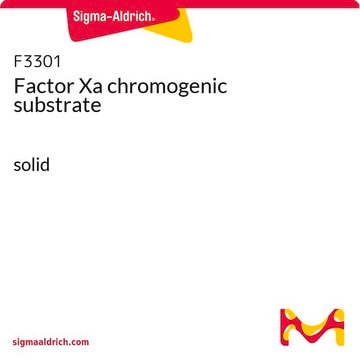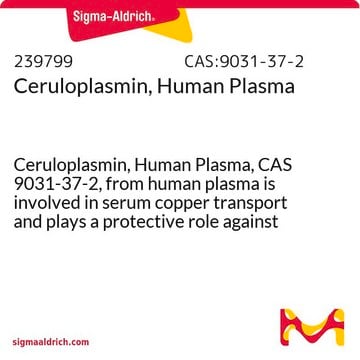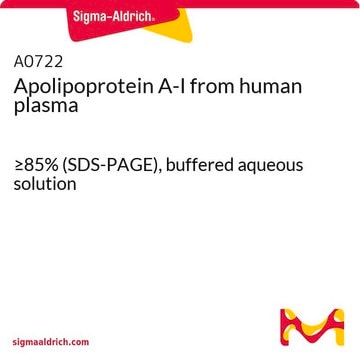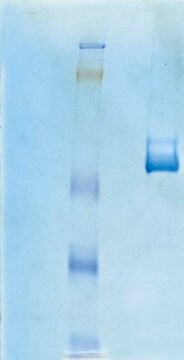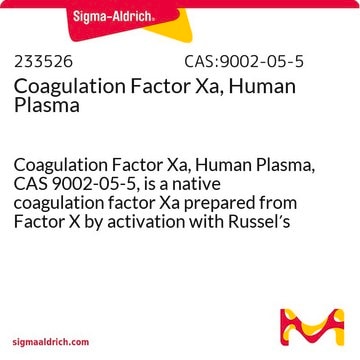This product forms an initial 1:1 complex to thrombin, followed by a slower rate of aggregation relative to bovine proteins. For assay purposes, in QC, the interaction of heparin, thrombin, and antithrombin III is allowed to proceed at 25°C for exactly two minutes and the residual thrombin activity in the reaction is measured for calculation. A brief search of the literature shows that ATIII is a serine protease inhibitor that irreversibly inactivates thrombin, a serine protease, in a 1:1 complex. It is recommended to test in this application to determine if there is residual thrombin activity.
A2221
Antithrombin III from human plasma
lyophilized powder, ≥95% (SDS-PAGE)
Synonim(y):
Factor Xa inhibitor, Heparin cofactor
Wybierz wielkość
975,00 zł
Wybierz wielkość
About This Item
975,00 zł
Polecane produkty
pochodzenie biologiczne
human plasma
Poziom jakości
Próba
≥95% (SDS-PAGE)
Formularz
lyophilized powder
numer dostępu UniProt
temp. przechowywania
−20°C
informacje o genach
human ... SERPINC1(462)
Szukasz podobnych produktów? Odwiedź Przewodnik dotyczący porównywania produktów
Działania biochem./fizjol.
Powiązanie
Definicja jednostki
Postać fizyczna
Oświadczenie o zrzeczeniu się odpowiedzialności
Kod klasy składowania
11 - Combustible Solids
Klasa zagrożenia wodnego (WGK)
WGK 3
Temperatura zapłonu (°F)
Not applicable
Temperatura zapłonu (°C)
Not applicable
Wybierz jedną z najnowszych wersji:
Certyfikaty analizy (CoA)
Nie widzisz odpowiedniej wersji?
Jeśli potrzebujesz konkretnej wersji, możesz wyszukać konkretny certyfikat według numeru partii lub serii.
Masz już ten produkt?
Dokumenty związane z niedawno zakupionymi produktami zostały zamieszczone w Bibliotece dokumentów.
Klienci oglądali również te produkty
Protokoły
Thrombin is an endolytic serine protease that selectively cleaves the Arg–Gly bonds of fibrinogen to form fibrin and release fibrinopeptides A and B.
-
Would incubation of bovine thrombin with antithrombin in 1:1 ratio in the presence of heparin for 5 min at 25 degrees Celsius, form irreversible thrombin-antithrombin complex and prevent thrombin's ability to degrade Tos-Gly-Pro-Arg-ANBA-IPA substrate?
1 answer-
Helpful?
-
-
Dear, could you please provide me information what is the best way to dissolve product A2221 (Antithrombin III from human plasma)? Could I use distilled water? Would it be soluble at concentration 0.4 mg/ml? Thank you. Kind regards, Dusan
1 answer-
This product is lyophilized from a solution containing 20 mM Tris, pH 8.0. For testing purposes, the material is reconstituted in the same buffer. The solubility of this product in water has not been validated. However, similar available products are listed as being water soluble.
Product SAE0102, lyophilized from PBS, pH 7.4., soluble in water at 0.1 mg/mL
Product 169756, lyophilized from 100 mM sodium citrate buffer, 20 mM Tris-HCl, pH 8.3, soluble in water on a lot specific basis, approximately 1mg/mL
Product 1040504, USP reference standard lyophilized from 0.05 M Tris, 0.15 M NaCl, pH 7.4, 2 mg/mL of trehalose, and 10 mg/mL of human albumin. - water soluble, no rate givenHelpful?
-
-
What is Antithrombin III from human plasma, Product A2221, soluble in?
1 answer-
The manufacturer has found it to be soluble in 50 mM Tris buffer with 150 mM sodium chloride. (No specific pH or concentration was provided.)
Helpful?
-
-
What is the Department of Transportation shipping information for this product?
1 answer-
Transportation information can be found in Section 14 of the product's (M)SDS.To access the shipping information for this material, use the link on the product detail page for the product.
Helpful?
-
-
What is the molecular weight for Antithrombin III from human plasma. Product A2221?
1 answer-
The molecular weight of Antithrombin III from human plasma is approximately 53 kDa.
Helpful?
-
-
The Antithrombin III from human plasma, Product A2221, vial appears to be empty. What should I do?
1 answer-
What you are observing is normal for this product. Each vial has sub-milligram amounts in it (either 25 or 125 micrograms), which may not be visible. One should reconstitute the vial, and measure the absorbance at 280 nm to show that it does have protein present.
Helpful?
-
-
What is the specific activity of Antithrombin III from human plasma?
1 answer-
We do not have strict specifications for the specific activity of the A2221. It is typically in the range of 40-80 units per mg protein. The value is reported on the certificate of analysis for each lot.
Helpful?
-
Active Filters
Nasz zespół naukowców ma doświadczenie we wszystkich obszarach badań, w tym w naukach przyrodniczych, materiałoznawstwie, syntezie chemicznej, chromatografii, analityce i wielu innych dziedzinach.
Skontaktuj się z zespołem ds. pomocy technicznej


